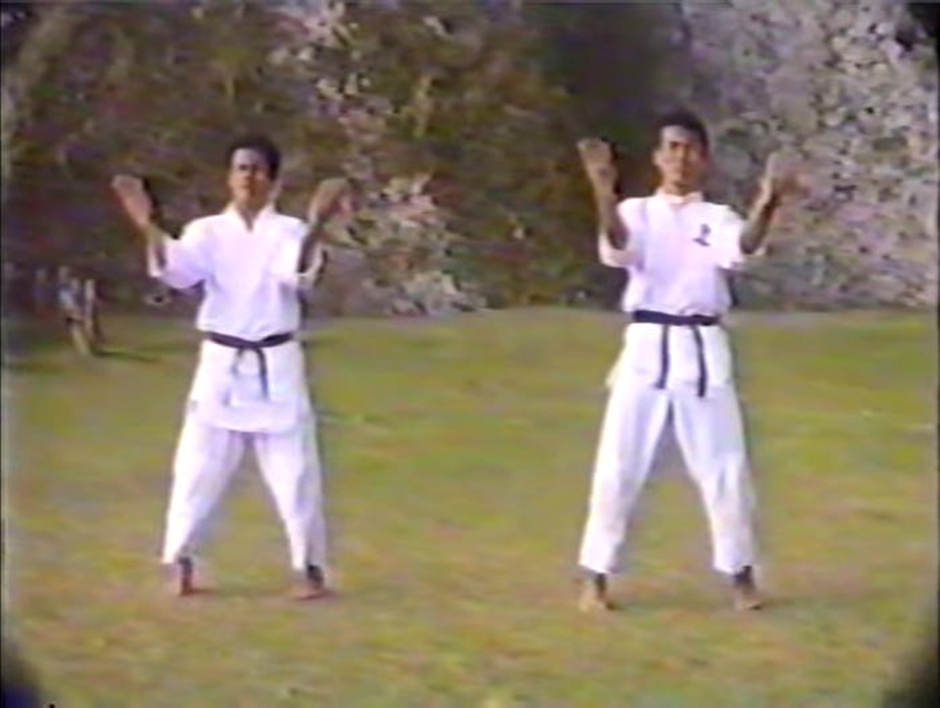(Translated to French by Jean-Charles
Juster, to English from French by Robert Young, Shared with Permission of Motobu Naoki)
https://medium.com/@motobu715/muutudii-et-sanchin-c2c61cd07040
The Motobu Udun dii has basic forms called Muutu dii. There are two kinds, called ichi (one) and ni (two). The first is done with clenched fists, the second with open hands. The images below show Muutudii ni performed with open hands.
https://www.youtube.com/watch?v=7A5k4emukhA
It resembles the Sanchin of the Gōjū school, but according to Master Uehara Sekichi, it is very different from the kata of the Gōjū-ryū. In fact, in this school one performs this kata with clenched fists, and, in this case, one performs Muutudii with open hands. In addition, Sanchin is accompanied by a particular breath called ibuki (forced breathing), whereas in Muutudii is natural. In addition, in the Gōjū, the toes are oriented inwards, according to an "internal hachimonji position: uchi hachimonji", but in Muutudi, they are roughly parallel. And also, the general posture or the way to lock the knees is also different.
Master Uehara learned it from Master Motobu Chôyû, but as in other schools there is no Muutidi, I initially thought in the past that it was a creation of Master Chôyû. However, several decades ago, I heard disciples of Master Uehara from the 1950s say, “Back then, we called him Sanchin!” ", I then came to think that perhaps Muutudi is Sanchin". In this case, this would mean that originally, the Sanchin of the Gôjû school was done in a form close to an execution with open hands and with natural breathing.
The current Muutudii is carried out according to the model: move forward three steps and turn around, move forward again by three steps and turn around, and once again move forward three steps. I learned from disciplines of the time that this form was established around the time of the first Motobu-ryû Sashiki Demonstration which took place in Sashiki (now Nanjô) in 1974. Until then, it seems that the The execution model consisted of starting from one wall and moving towards the opposite wall, and when you reached it, you turned around and moved forward again. In other words, it was not a kata with a fixed form.
According to Higa Kiyohiko who had learned with master Uehara in the years 1950–1960, there was this format, but also a fixed form and his father (Higa Seitoku) had learned it. So would this mean that from the beginning, there was indeed a fixed form for Muutudii? As Master Uehara taught different movements to different disciples, this is a plausible version. Otherwise, there is also a Sanchin transmitted by Matsumura Sôkon, called “Shô Sanchin” [“Shô” being the other reading of the pine character “matsu” which happens to be the first sign of Matsumura’s name].
So, was there a Sanchin in the shurite?, many intrigued people will ask.
In fact, in addition to Master Uehara, the current sôke, Motobu Chôsei, heard from Mr. Miyagi Chôjô, a person originally from Okinawa who lived in his neighborhood, a testimony according to which Master Chôyû taught Sanchin.
(Photograph: from left to right: the family of Motobu Chôsei, Uehara Seikichi, and jumping a person Miyagi Chôjô: Osaka, 1976)
It seems that Mr. Miyagi learned a little karate from Master Chôyû for a short time. And according to him, the latter then taught Sanchin. Furthermore, this same Mr. Miyagi told the legatee of our school the following thing. “Among Master Chôyû’s disciples, there was a truly gifted young man who was extraordinarily powerful. When he made Sanchin, the grass that passed under his feet was torn out.”
This is how there was indeed a Sanchin in the shurite. However, why did this kata suddenly disappear? This is another mystery in the history of karate.

